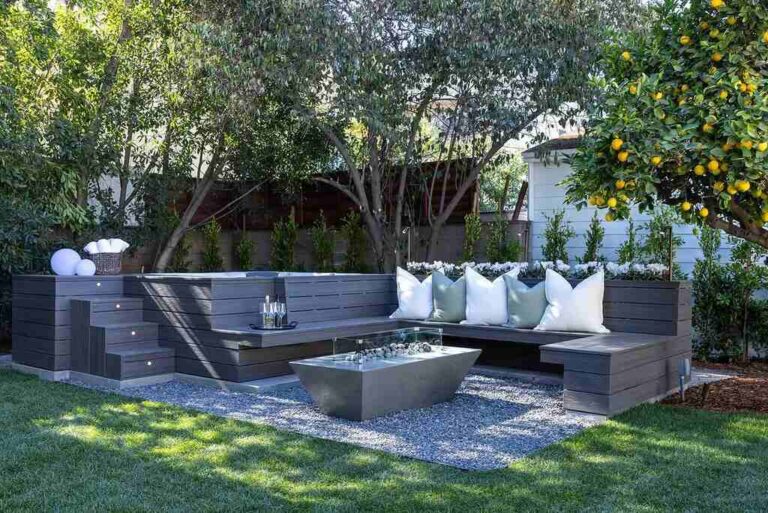That patch of green outside your window? It’s not just empty space. It’s your ticket to everyday happiness. Your outdoor area can become the place you run to, not from. A spot that gives you a deep breath when life gets a little too noisy.
Most of us spend way too much time indoors. We stare at screens until our eyes hurt and forget what fresh air feels like. But what if the remedy was right outside your door?
I’ve seen countless outdoor spaces transform from forgotten corners into magical retreats. The coolest part? It doesn’t take a mountain of money or professional help to make it happen. Just some thoughtful planning and personal touches that speak to who you are.
Ready to create your own little slice of paradise? Let’s jump into how you can turn that neglected patio, tiny balcony, or backyard low maintenance into the escape you didn’t know you needed.
9 Tips To Turn Your Outdoor Space Into A Daily Escape
Creating an outdoor escape isn’t about following strict rules. It’s about crafting a space that pulls you outside every chance you get. These tips will help you build a spot that feels like it was made just for you.
Define Your Outdoor Zones
Think of your outdoor space like a tiny house. Even the smallest balcony can have different “rooms” if you plan it right.
Maybe you need a spot for morning coffee, another for afternoon reading, and a third for evening gatherings. By dividing your space into zones, even a modest area starts feeling bigger and more useful.
You can mark these zones without walls. Try using different right flooring materials like deck tiles in one area and pea gravel in another. Or position a planter or outdoor rug as a natural divider.
The magic happens when each zone has its own purpose. Your morning coffee spot might face east to catch sunrise rays. Your dining area could sit near the house for easy food transport. That quiet reading corner? Tuck it under a tree for natural shade.
Whether you’re envisioning a cozy reading nook, a lush garden retreat, or pickleball court that brings friends and family together, starting with clear zones helps every other design decision fall into place.
Choose Comfortable Seating
Let’s be honest. If your outdoor chairs hurt your back, you won’t use them. Period.
Comfort is king when it comes to outdoor seating. Think about how you’ll actually use your space. Do you love to nap outside? An outdoor daybed might be worth the splurge. Love hosting friends? Maybe a sectional makes more sense than individual chairs.
Weather-resistant cushions aren’t optional—they’re essential. Look for fabrics made specifically for outdoor use that resist fading and mildew. And don’t forget pillows! They add color and make hard surfaces way more inviting.
Consider unexpected seating options too. Built-in bench seating along walls or railings saves space while providing spots for lots of people. Hammocks create instant vacation vibes. Even floor cushions can work if you’re tight on space or budget.
The true test of good outdoor seating isn’t how it looks in photos. It’s how long people want to stay there. When guests linger for hours instead of minutes, you’ve nailed it.
Incorporate Natural Elements
Plants aren’t just pretty—they’re game changers for outdoor spaces. They clean the air, provide privacy, and simply make us feel good.
If you’re short on ground space, think vertical. Wall planters, hanging baskets, and tall grasses create green impact without eating up precious floor room. For container gardening, bigger pots actually require less maintenance since they don’t dry out as quickly.
Beyond plants, natural materials like wood, stone, and rattan add warmth no plastic can match. Even small touches count—a stone birdbath, wooden plant stands, or bamboo wind chimes.
Not blessed with a green thumb? Start with hard-to-kill options like succulents, snake plants, or hostas. Native plants also need less babying since they’re already adapted to your climate.
The goal isn’t creating a botanical garden that demands hours of upkeep. It’s adding enough living elements to make your space feel connected to nature—even if it’s a tiny urban balcony.
Add Ambient Lighting
Outdoor lighting is where function meets pure magic. Without it, your beautiful space disappears after sunset.
String lights remain popular for good reason—they create instant atmosphere with minimal effort. Hang them in zigzags overhead or outline your space’s perimeter. For a more permanent solution, consider installing LED strip lighting under bench seating or along railings.
Solar-powered options have come a long way. They save energy and spare you from running electrical lines. Place solar pathway lights along walkways for safety or tuck uplights near plants to create dramatic shadows after dark.
Candles and lanterns add a flickering glow nothing electric can duplicate. Battery-operated versions give you the look without fire concerns. Group them in different heights on tables or steps for maximum impact.
The best outdoor lighting plans include layers—task lighting for cooking or reading, accent lighting to highlight special features, and ambient lighting for overall glow. When done right, good lighting extends your outdoor hours well into the evening.
Create Shade and Shelter
Without proper shade, even the prettiest outdoor space sits empty on hot or rainy days.
Umbrellas offer affordable, movable shade, but permanent structures provide more reliable protection. Pergolas with retractable canopies give you flexibility to enjoy sun or shade as weather dictates. For smaller spaces, a simple sail shade can block harsh rays while adding architectural interest.
Consider natural shade too. Fast-growing trees shaped like maples or poplars can shade seating areas within a few years. Climbing vines on trellises create living screens that filter sunlight while adding privacy.
Weather protection isn’t just about blocking the sun. Think about wind breaks for blustery days and rain coverage for light showers. Outdoor curtains can block both while adding softness to structured spaces.
The goal isn’t creating a completely controlled environment—that’s what indoors is for. It’s making your outdoor space usable in more conditions, so your daily escape doesn’t depend on perfect weather.
Include Water Features
There’s something about water that instantly calms us down. The good news? You don’t need an elaborate pool to get the benefits.
Small-scale water features work in nearly any space. Tabletop fountains need just electricity and occasional refills. Wall-mounted water panels create vertical interest in tight quarters. Even a simple bird bath adds moving water when feathered friends stop by for a splash.
Sound matters as much as sight. The trickle of water masks traffic noise and neighbor conversations, creating a sense of privacy even in busy areas. Different fountain designs create different sounds—from gentle bubbling to more dramatic splashes.
If maintenance concerns you, closed-system fountains recirculate water with minimal evaporation. Some newer models even run on solar power, eliminating the need for electrical connections.
Water features work hardest when placed where you’ll actually see and hear them. Position them near seating areas rather than at the far end of your space. The soothing effects work best when the water becomes part of your everyday experience.
Integrate Scent and Sound
The most memorable outdoor spaces engage all your senses—not just your eyes.
For natural fragrance, skip artificial sprays and plant aromatic herbs and flowers instead. Lavender, mint, jasmine, and roses release scent whenever you brush past. Plant them along pathways or near seating for maximum enjoyment. Herbs pull double duty by flavoring your cooking too.
Sound deserves equal attention. Wind chimes add gentle tinkling on breezy days. Water features contribute their own soundtrack. Even carefully positioned plants like ornamental grasses rustle soothingly when wind passes through.
For spaces where outside noise intrudes, consider a small outdoor speaker for nature sounds or favorite music. The goal isn’t creating concert-level volume, but just enough pleasant sound to mask unwanted noise.
These sensory elements often cost less than big-ticket items like furniture, but they’re what transforms an outdoor space from merely nice-looking to deeply enjoyable. They’re the difference between a space you visit and one you experience.
Personalize with Decor
Generic outdoor spaces don’t inspire daily use. Your outdoor area should feel as personal as your living room.
Outdoor art weatherproofs your personality. Metal sculptures, mosaic tiles, stepping stones, or painted fence panels add one-of-a-kind character. Even practical items like house numbers or mailboxes can become statement pieces with a little creativity.
Textiles inject color and comfort. Weather-resistant rugs define seating areas while cushions and throws invite lingering. Choose colors and patterns that make you happy—not just what matches your house exterior.
Don’t forget about surprising elements that spark joy. A tiny fairy garden tucked among plants. Wind spinners that catch sunlight. A vintage watering can repurposed as a planter. These small touches often become favorite features.
The best outdoor spaces tell your story. They contain things that make visitors say, “That’s so you!” These personal touches transform generic patios and yards into places that feel like a natural extension of your home.
Make it Functional and Convenient
The most beautiful outdoor space sits unused if it’s a hassle to enjoy.
Think about what would make daily use easier. Storage boxes for cushions mean you don’t haul them in every time clouds appear. An outdoor sideboard keeps dining supplies handy. Even a simple hook for towels makes pool or hot tub use more appealing.
Weather considerations matter too. Positioning furniture on slightly elevated areas prevents soggy seats after rain. Drain holes in planters prevent root rot. Furniture covers extend the life of investments you’ve already made.
Convenience extends to maintenance as well. Choosing perennial plants over annuals means less seasonal replanting. Self-watering planters help greenery survive forgotten waterings. Even selecting furniture materials based on your tolerance for upkeep makes a difference.
The most successful outdoor spaces balance beauty with practicality. They look great in photos but also function smoothly in real life—making them places you actually use rather than just admire from indoors.
Conclusion
Your outdoor space holds so much potential. It can be the spot where you sip morning coffee in a peaceful quiet. The place where you watch fireflies with someone special. Your personal retreat when work stress follows you home.
Creating this daily escape isn’t about spending thousands or hiring professionals. It’s about thoughtful choices that match how you really live. Start with just one or two tips from this list. See what works. Add more as time and budget allow.
The perfect outdoor space isn’t one that looks like a magazine spread. It’s one that pulls you outside day after day. One that makes you pause and breathe deeper. One that helps you remember what matters most.
Your daily escape is waiting just beyond your door. All it needs is your attention to become the outdoor space you’ve always wanted.



